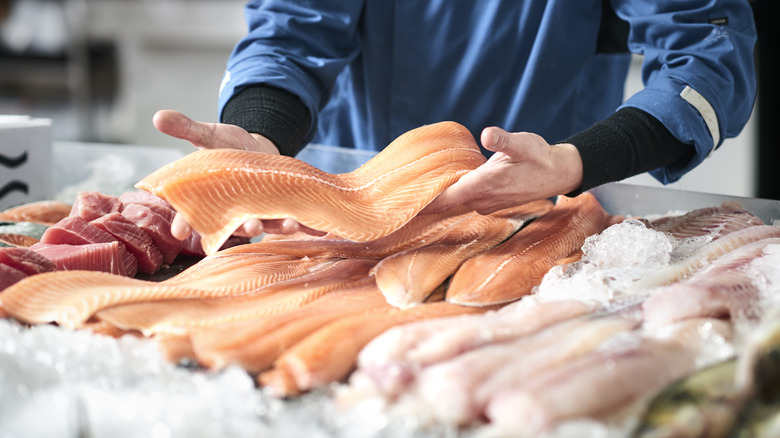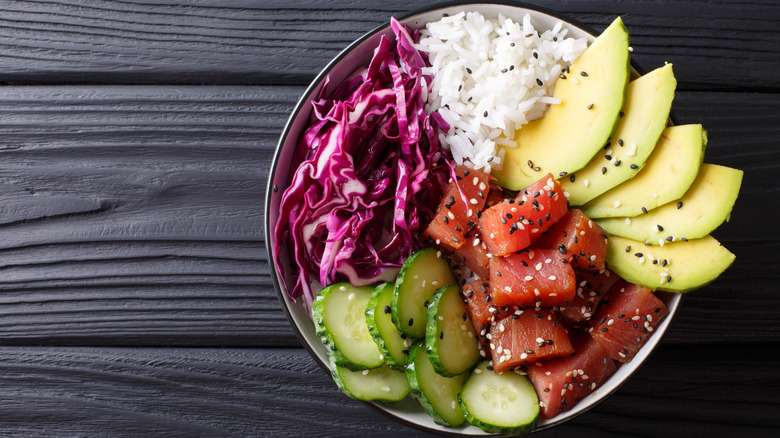Why Tuna Is One Of The Only Fish You Should Prepare Raw At Home
Fish plays a vital part in humans' diets globally, but raw fish is often associated with just a few dishes: sashimi and sushi, ceviche (if you're unfamiliar, Serious Eats explains the dish is made from raw seafood mixed with an acidic marinade), tartare (usually made with tuna), and crudo (a general term for raw preparations, explains Modern Farmer). And if you have yet to notice a Hawaiian poke spot pop up in your neighborhood, you're likely to soon; the market is expected to grow 71% in North America by 2026, according to a report from technology and research company Technavio.
With all these delicious raw fish options, it might be tempting to look at your grocery store's fish counter and try to recreate your favorite yellowtail crudo or mackerel sashimi in your kitchen. But experts warn to be careful when trying to recreate these dishes at home, recommending you perhaps stick to tuna.
The risks of preparing raw fish yourself
While eating raw fish is tasty and nutritious (Healthline explains seafood can actually lose certain nutritional qualities when cooked), it can also be risky. Not cooking fish comes with a heightened possibility you'll contract a foodborne illness and spend an unfun day vomiting, as raw fish can cause bacterial infections in the form of Salmonella or Listeria.
Uncooked fish can also play host to a number of parasites like tapeworms and roundworms; This is especially true for freshwater fish, Serious Eats notes, which should almost never be eaten raw. Alaskan King Crab Co. says you should avoid some marine fish as well, including pollock and haddock.
Part of the problem with preparing raw fish at home is how difficult it can be to find fish that is safe to eat raw. Many people do not live near a fish market that offers "sushi-grade" options, and even when they do it doesn't always guarantee safety, as the term is not regulated by the government in the U.S. So while the safest choice is cooking your fish until it's reached an internal temperature of 145°Farenheit, according to the FDA, you do have some options if you want that raw fish experience without leaving your house.
You can probably trust raw tuna
Serious Eats explains the term "sushi-grade" was invented as more of a marketing gimmick to denote the quality of a piece of fish. Not only does this labeling often exclude some fish that you can safely eat raw, but — as stated above — it also is not given out by an official body in the U.S. Fish markets themselves decide what counts as sushi-grade, meaning you have to trust that specific store's assessment.
But that doesn't mean you should ignore the marker entirely. Alaskan King Crab Co. notes it normally indicates the fish has been "frozen at a very low temperature," as laid out by FDA, which kills any parasites and bacteria present in the raw fish, making it safer to eat. However, tuna is an exception to the FDA's freezing rule, as Serious Eats points out it rarely contains parasites and thus doesn't have to be frozen to the extreme degree as other fish in order to be safe for consumption.
This means that while sushi menus may draw on many species of fish, unless you're an expert in identifying fish quality, picking tuna from the fish case is your best bet if you're preparing a dish featuring raw fish at home. However, while tuna may be safer to eat raw than most other types of fish, its potentially high levels of mercury mean you probably shouldn't eat it every night (via Healthline).


